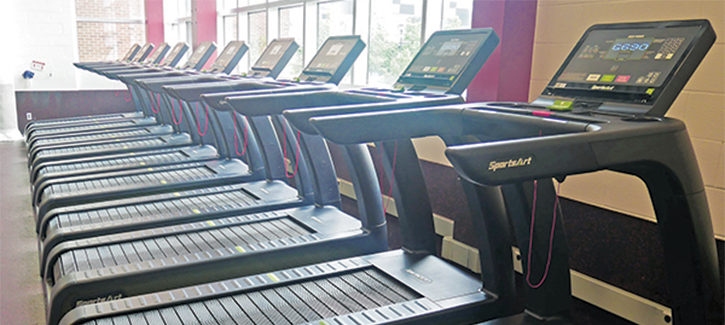When the Athletic and Recreation department at York University (YU) began searching for companies offering full lines of electricity-generating cardiovascular equipment, administrators thought there would be many choices. However, Art McDonald, the manager of Fitness and Well-being, said only one company provided what the school was looking for: SportsArt.
“It turned out to be an easy decision,” said McDonald. “Not only do they have the technology, but their company is rooted in genuine care for the planet. We sought out SportsArt because they were the only fitness equipment providing company that cared as much about the planet as we do here at York University.”
McDonald provides more details below on YU’s collaboration with SportsArt.
Campus Rec Magazine: How have today’s students changed the traditional operation of a campus rec center?
Art McDonald: I’ve found today’s students have changed recreation operations in two meaningful ways:
- First, there is more permission to try some transformational concepts. In the past, there may have been quicker criticism of leadership if new concepts were attempted without it being led by the students. Now, there seems to be a bit more openness to new ideas and more curiosity.
- Second, there’s the active demand about things like sustainability that students are much more passionate about than they were years ago. There is a positive energy around obvious changes. We are proud to fight social injustices at YU. The students are very comfortable speaking about items important to them.
CRM: Why did you decide to partner with SportsArt? What problem were you looking to solve, or what solution were you looking to incorporate?
AM: We naively thought there would be many companies offering electricity-generating cardiovascular equipment. We presumed we were at the point where people had multiple choices on important things like the people and the planet. If you care about humanity, be kind and smile more. If you care about the planet and animals, choose animal-free options in the grocery store. If you care about the planet and our out-of-control energy consumption, choose the treadmill that generates power instead of the one that consumes power.
CRM: What are the students’ reactions to learning that their exercise is also helping the planet?
AM: Some students are thankful we have the equipment because they’ve known the technology exists and wondered what took us so long. Some students are pleasantly surprised to hear the technology exists. Other students react as though it’s a simple decision that shouldn’t take much thought and we shouldn’t be so proud because it’s such an obvious choice. The latter makes me smile. I’m hopeful this becomes a much simpler process for other students and universities in the future.
One other reaction I’ve noticed is when students realize what kind of energy is being generated by their workout and they compare that with the kind of energy required to leave lights on all day, they seem a little more reluctant to waste energy elsewhere. This is just anecdotal but there may be some nice, indirect energy benefits from these pieces of equipment as well.
CRM: What has your experience been working with SportsArt?
AM: I’ve thoroughly enjoyed my time with SportsArt. It may simply be because we are like-minded, which helps keep a positive energy around all dialogue. I think it’s also because they are extremely professional. Our equipment installation was a big job with a lot of moving parts. In addition to being well-organized, I felt very looked after by the entire SportsArt team. I still feel very connected months after the installation. They’ve listened when I had many questions and they’ve always followed up with more support than I initially expected. If they don’t have answers, they find or create them. It’s a very progressive company with a beautifully rooted foundation.
What else can you tell other campus rec center professionals about the benefits of working with SportsArt?
AM: For anyone else considering this type of change, I know it can seem risky and unconventional. SportsArt took those anxieties away. Each university will have red tape and policies and practices that may inhibit forward-thinking like this. But SportsArt shared experiences that put me at ease right away. They’ve been able to work on new solutions for any surprises thrown their way.
Admittedly, this would have been a difficult process for us if we didn’t have a company as supportive as SportsArt. We are a large university with a lot of obstacles for a project like this, but we got through it in large part because of what SportsArt offers like leasing options, technical support, exercise programming suggestions, marketing and communications, and preventative maintenance packages. I encourage this type of transformational thinking for universities curious about other ways they can make a positive difference for the planet.
For more information, visit gosportsart.com.










